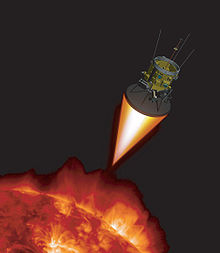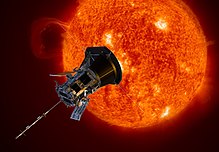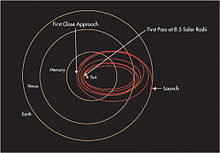Parker Solar Probe
| Parker Solar Probe | |||||||||||||||||||||||||||||||||||||
|---|---|---|---|---|---|---|---|---|---|---|---|---|---|---|---|---|---|---|---|---|---|---|---|---|---|---|---|---|---|---|---|---|---|---|---|---|---|
 Mission emblem |
|||||||||||||||||||||||||||||||||||||
| NSSDC ID | 2018-065A | ||||||||||||||||||||||||||||||||||||
| Mission goal | Exploring the sun | ||||||||||||||||||||||||||||||||||||
| Client |
|
||||||||||||||||||||||||||||||||||||
| Launcher | Delta IV Heavy | ||||||||||||||||||||||||||||||||||||
| construction | |||||||||||||||||||||||||||||||||||||
| Takeoff mass | 685 kg | ||||||||||||||||||||||||||||||||||||
| Instruments | |||||||||||||||||||||||||||||||||||||
|
SWEAP, WISPR, FIELDS, IS☀IS-EPI, HeliOSSP |
|||||||||||||||||||||||||||||||||||||
| Course of the mission | |||||||||||||||||||||||||||||||||||||
| Start date | August 12, 2018, 07:31 UTC | ||||||||||||||||||||||||||||||||||||
| launch pad | Cape Canaveral , LC-37B | ||||||||||||||||||||||||||||||||||||
| End date | 2025 (planned) | ||||||||||||||||||||||||||||||||||||
|
|||||||||||||||||||||||||||||||||||||
Parker solar sample (formerly Solar Probe Plus ) is a spacecraft of the NASA to explore the sun , and in particular its outermost layer of the atmosphere, the corona . The spacecraft launched on August 12, 2018; it is expected to reach its point closest to the sun ( perihelion ) for the first time on December 24, 2024 . The probe was named after the American astrophysicist Eugene N. Parker , of the term ( "solar wind" solar wind ) coined.
Mission objectives
The probe should explore the corona:
- The flow of energy that heats the corona to several million degrees Celsius and accelerates the solar wind
- The structure of plasma and magnetic field at the point where the solar wind originates
- The mechanism that accelerates and transports high-energy particles
The outer corona is statistically evaluated to clarify the questions. The results should provide an explanatory model. For this purpose, Parker Solar Probe should approach the sun's surface to within 8.5 solar radii (approx. 5.9 million km, or 4% of the Earth's orbit radius ).
prehistory
The idea of a space probe designed to study the sun at extremely close quarters was first mentioned in October 1958 in a study by the US National Academy of Sciences . Since the high temperatures in such proximity to the sun were not manageable at the time, only studies were made over the decades. The first missions were carried out in the 1970s with the Helios 1 and 2 probes , which were a joint project of the German Aerospace Center and NASA.
Original concept from Solar Probe
According to the original mission planning , Parker Solar Probe was to be launched from an Atlas V 551 with an additional Star 48 kick stage to Jupiter and deflected by it into a highly elliptical , polar solar orbit inclined at 90 ° to the ecliptic by means of a swing-by maneuver , whose perihelion should be only three solar radii above the sun's surface. In order to withstand the extreme heat in three solar radii above the sun's surface, a tapered solar protection was provided, which was shown glowing from the heat in some design studies. The actual probe body would have been in the shadow of this 2.7 m wide sun protection, and only the tips of the plasma antennas would have protruded from its shadow cone. Since solar cells can not be used when flying past Jupiter and because of the high temperatures in extreme proximity to the sun , Solar Probe should obtain the necessary electrical energy from three multi-mission radioactive thermoelectric generators (MMRTGs, see radionuclide battery ), which should be installed directly below the sun protection shield . During the approximately nine-year mission, the Solar Probe was to pass the perihelion of four solar radii above the center of the Sun twice at a speed of 308 km / s and fly over the sun coming from the south. The starting mass of the Solar Probe should be approx. 856 kg. However, because of the MMRTGs, the concept turned out to be too expensive for NASA.
Design change
NASA commissioned a second study for a probe without RTGs from the Applied Physics Laboratory (APL) at Johns Hopkins University (JHU), which was already planning the original solar probe. In 2009, the JHU-APL published a significantly modified design of the Parker Solar Probe with a hexagonal sun protection shield with rounded corners, which is wider on the two sides to which the solar cell wings are attached than on the other. The launch mass of the probe is 685 kg. Structurally, the probe consists of a six-sided prism, one (wider) end of which bears the thermal protection shield. All systems with the exception of a few antennas are installed behind this shield or can be folded behind it. The entire probe reaches a height of 3 m, with a largest diameter of 2.3 m and a smallest diameter of 1 m on the adapter to the carrier.
Sun shield
The spiral approach to the Sun and the short final orbit will allow Parker Solar Probe to get close to the Sun 24 times, rather than just twice as planned for the original Solar Probe . Due to the greater minimum distance from the sun compared to the Solar Probe , the heat radiation is only one sixteenth of the value that would have been achieved with the Solar Probe . This means that a plate-shaped sun shield with a diameter of 2.7 m and a thickness of 17 cm is sufficient for the Parker Solar Probe , the side facing the sun must withstand approx. 1430 ° C. The thermal protection shield has to withstand a heat flow of almost 1 MW / m², the solar radiation is about 650 times more intense than at a distance from the earth.
power supply
The solar cell paddles are only one piece, and the secondary solar cell wings have disappeared. Your solar cells are now apparently at the end of the foldable solar cell wings on a narrow, angled surface which, after folding back most of the two solar cell wings in the shadow of the sun shield, point towards the sun. The solar cells can generate 388 W of electrical power.
The probe body is always in the shadow of the sun shield. Parker Solar Probe has two different solar cell systems for power supply . The primary solar cells are located on two two-part solar cell wings sitting on opposite sides, which are swiveled back up to 75 ° when approaching the sun in order to keep their temperature below 180 ° C. If the distance from the sun falls below 0.25 AU , they can be retracted completely, as at the start. Then the two secondary high-temperature solar cell surfaces, which look out from behind the sun protection on opposite sides, take over the power supply. They are liquid-cooled from the rear and drawn in further as they approach the sun.
communication
Data transmission takes place in the K a -band with 34 W output power and a parabolic antenna of 0.6 meters in diameter at the end of an extensible mast. If the distance from the sun falls below 0.59 AU, the antenna is folded back into the shadow of the sun protection shield. Therefore, all measurement results of the nearby sun fly-bys must be saved on board before the antenna can be extended again to transmit them to earth. Besides has Parker solar sample still X-band -Rundstrahlantennen to transmit telemetry and reception of control signals, which constantly remain in the shadow of the sun shield.
Instruments
Parker Solar Probe essentially carries four instruments:
- FIELDS measures electric and magnetic fields and waves as well as plasma and electron density. The lead scientist is Stuart Bale of the University of California, Berkeley .
- IS☉IS (Integrated Science Investigation of the Sun) observes high-energy electrons, protons and ions in the range of several 10 keV to 100 MeV, which are to be used for correlation with solar wind measurements and structures of the corona. The lead scientist is David McComas, Princeton University . The notation IS☉IS contains the symbol of the sun.
- WISPR (Wide-Field Imager for Solar PRobe) is a telescope system for observing the corona and the inner heliosphere. It is supposed to detect shocks, waves and other structures of the solar wind and make them visible. Russell Howard, Naval Research Laboratory, is the lead scientist .
- SWEAP (Solar Wind Electrons Alphas and Protons Investigation) is a trio of particle counters for determining the speed, density / flow rate and temperature of electrons, protons and helium nuclei, the most common particles in the heliosphere. The lead scientist is Justin Kasper, University of Michigan / Smithsonian Astrophysical Observatory .
Another research task is: Heliospheric Origins with Solar Probe Plus (HeliOSPP). The lead scientist is Marco Velli (University of California, Los Angeles).
Construction and testing
The probe's instruments were delivered in 2017 and the entire probe was subjected to intensive tests in summer 2017. In autumn 2017, the probe was delivered to the Goddard Space Flight Center . After further testing, she was flown to the launch site in Florida on April 2, 2018.
begin
The launch of the space probe in Cape Canaveral was originally scheduled for August 11, 2018, but then had to be postponed by one day due to technical problems (helium pressure). The start window was open from August 12 to 23, 2018. The launch finally took place on August 12, 2018 at 07:31 UTC (3:31 EDT local time) with a Delta IV Heavy and a payload take-off mass of 685 kg. The course initially led to Venus, and after a total of seven swing-bys on Venus , it is expected to reach its point closest to the sun for the first time on December 24, 2024.
course
The first flyby of Venus took place on October 3, 2018. Three months after take-off, it reached the first perihelion with a distance of 35 solar radii from the center of the sun. Communication with the probe is not possible during perihelion; the data collected during this time can only be sent at a greater distance from the sun. With further swing-by maneuvers on Venus, Parker Solar Probe transfers further orbital energy to Venus, whereby the perihelion is always closer to the sun's surface. After the seventh swing-by, Parker Solar Probe approaches the sun's surface up to 8.5 solar radii (approx. 5.9 million km) in perihelion. The heliocentric speed of the probe then reaches 200 km / s. This final orbit has an aphelion of 0.73 AU with a 3.4 ° inclination to the ecliptic and an orbital period of 88 days. The mission duration is set at 24 orbits around the sun and until 2025, i.e. about seven earth years.
- October 3, 2018, 08:44 UTC: First flyby of Venus, already at the first crossing of Venus' orbit, which is the closest planet inward from Earth. In doing so, the probe was braked and so came onto an eccentric orbit closer to the sun.
- November 2018: First perihelion (point closest to the Sun) after completing the first half-ellipse at 35.7 solar radii R S at a distance of about 0.16 AU. Here, due to the attraction of the sun, the probe reached the highest orbital speed of its first orbit.
- September 1, 2019 around 05:50 UTC: Third perihelion at approximately the same distance as the first.
According to the orbit graphics of the JHU-APL, the large orbit ellipse diameter initially still has approx. 85% of the same dimension as the almost circular Venus orbit. According to Kepler's third law , the probe has a shorter orbital time than Venus, but also a lower average speed.
In the course of a further six fly-bys of Venus, the probe orbit ellipse should become smaller (up to about 50% of the Venus orbit diameter) and more eccentric. The Aphel engaged from the outside in the region of the Venus web, Perihel to even closer towards the sun and a first minimum at 8.86 R S achieve.
On the last three orbits with an orbital period of 88 days, the solar probe should come close to the sun within 9 R S , which corresponds to 6.16 million kilometers and about a seventh the minimum distance of the previous record holder Helios. The current speed at the point closest to the sun (perihelion) should then be around 690,000 km / h or 190 km / s.
See also
- Solar Orbiter , ESA's solar probe , launched on February 10, 2020
Web links
- Parker Solar Probe at JHU-APL (English)
- Solar Probe: An Engineering Study, November 12, 2002 ( Memento from May 27, 2010 in the Internet Archive ) (English; PDF; 6.02 MB)
- Solar Probe + Mission Engineering Study Report, March 10, 2008 ( Memento from May 27, 2010 in the Internet Archive ) (English; PDF; 40.4 MB)
- Edward D. Flinn: Probing the Sun, Aerospace America, August 2008 (English; PDF; 899 kB)
- Gunter's Space Page: Solar Probe Plus (English)
- Solar Probe: Report of the Science and Technology Definition Team (PDF; 9.51 MB)
- Solar Probe + Plus: Report of the Science and Technology Definition Team (PDF; 9.67 MB)
- Dossier: Flight in the sun
swell
- ↑ a b NASA sends space probe to the sun , Frankfurter Allgemeine Zeitung , August 12, 2018.
- ^ Rob Garner: Parker Solar Probe Reports Good Status After Close Solar Approach. November 7, 2018, accessed September 24, 2019 .
- ↑ a b timeline. JHU / APL, accessed on December 19, 2019 .
- ↑ Jan Mahn: NASA renames first solar mission. In: heise online. Heise Zeitschriften Verlag, June 1, 2017, accessed on August 9, 2018 .
- ↑ NASA (Ed.): Parker Solar Probe; A Mission to Touch the Sun . ( jhuapl.edu [PDF]).
- ^ Dave McComas: Solar Probe Status Report. (PDF; 1.5 MB) (No longer available online.) March 2, 2004, formerly in the original ; accessed on February 1, 2010 (English). ( Page no longer available , search in web archives ) Info: The link was automatically marked as defective. Please check the link according to the instructions and then remove this notice.
- ^ Mission History. (No longer available online.) JHU / APL, formerly in the original ; accessed on February 1, 2010 (English). ( Page no longer available , search in web archives )
- ↑ Images from the Solar Probe: Report of the Science and Technology Definition Team. JHU / APL, September 2005, accessed on February 1, 2010 (English).
- ^ Mission History. (No longer available online.) JHU / APL, formerly in the original ; accessed on February 1, 2010 (English). ( Page no longer available , search in web archives ) Info: The link was automatically marked as defective. Please check the link according to the instructions and then remove this notice.
- ↑ Mission Overview. (No longer available online.) JHU / APL, formerly in the original ; accessed on February 1, 2010 (English): "protected by a carbon-composite heat shield that must withstand up to 2,600 degrees Fahrenheit"
- ↑ Artwork. (No longer available online.) JHU / APL, formerly in the original ; accessed on February 1, 2010 (English). ( Page no longer available , search in web archives ) Info: The link was automatically marked as defective. Please check the link according to the instructions and then remove this notice.
- ↑ animation. (No longer available online.) JHU / APL, formerly in the original ; accessed on February 1, 2010 (English). ( Page no longer available , search in web archives ) Info: The link was automatically marked as defective. Please check the link according to the instructions and then remove this notice.
- ^ NASA: NASA's Mission to Touch the Sun Arrives in the Sunshine State. April 6, 2018, accessed May 9, 2018 .
- ^ Launch Schedule. Spaceflight Now, July 27, 2018, accessed July 31, 2018 .
- ↑ Start of the first probe to the solar atmosphere postponed . Rhein-Neckar-Zeitung , August 11, 2018.
- ↑ JHUAPL: Parker Solar Probe: The Mission. Retrieved August 12, 2018 .
- ↑ Stephen Clark: Delta 4-Heavy selected for launch of solar probe , accessed on May 3, 2015 (English).
- ↑ Mission Overview. (No longer available online.) JHU / APL, formerly in the original ; accessed on February 1, 2010 (English): "At closest approach, Solar Probe would zip past the Sun at 125 miles per second"
- ↑ Parker Solar Probe Completes Third Close Approach of the Sun. NASA, September 3, 2019, accessed September 5, 2019 .






